
Features
Aggregates
Education
Event Reports
Pits & Quarries
Technology
Quarry Tech recap: Investments in new tech, projects required to support industry
Rock to Road's annual conference brings together aggregates experts to discuss industry issues, equipment and new products
October 19, 2021 By Kristina Urquhart
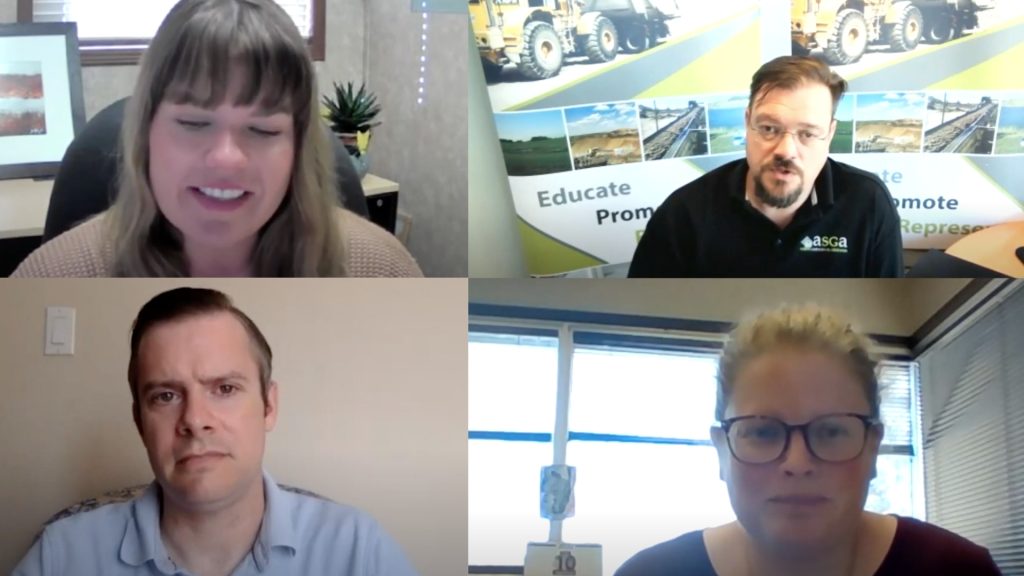 The "Importance of participation on sub-regional planning task forces" panel at Quarry Tech 2021. Clockwise from top left: Carley Dobko of NPA Ltd., John Ashton of ASGA, Lesley Foy of ASGA, and moderator Andrew Snook of Rock to Road.
The "Importance of participation on sub-regional planning task forces" panel at Quarry Tech 2021. Clockwise from top left: Carley Dobko of NPA Ltd., John Ashton of ASGA, Lesley Foy of ASGA, and moderator Andrew Snook of Rock to Road. Investments were the talk of Rock to Road’s Quarry Tech 2021 conference last week, from federal funding for infrastructure, to new technologies to help improve operations, to time spent on education and training.
Attendees gathered online on Oct. 14 to hear about the aggregates industry’s efforts to lobby government on critical issues, the latest equipment for data collection in pit and quarry operations, the future of artificial sand, and how companies are collaborating with researchers to preserve fossils found in sand and gravel pits.
The event was supported by gold sponsors Kleemann/Wirtgen Group, MB Crusher and Polydeck, and silver sponsors BKT, Frontline Machinery, Trimble Loadrite and Superior Industries.
Missed the broadcast? Register for free to watch the recordings, and read on for our recap.
Government relations: Laying the groundwork
John Ashton, executive director for the Alberta Sand and Gravel Association (ASGA), kicked things off with an overview of where the aggregate industry stands coming out of the Sept. 20 federal election.
With Infrastructure Minister Catherine McKenna’s recent retirement from federal politics, a new minister will be appointed when the federal cabinet is revealed later this fall. Several of McKenna’s large green infrastructure investments have yet to pass budget, so “the new minister will have a major impact on aggregate,” Ashton said.
He noted that there wasn’t much emphasis on new infrastructure investment in any party platform leading up to the election, including from the incumbent Liberals (read Rock to Road’s breakdown here). As a result, aggregate industry representatives will need to quickly meet with the new minister to get infrastructure on the agenda and ensure “a healthy aggregate industry but also a healthy country.”
“We need to build for the realities of a changing climate,” Ashton said, noting that Canada needs to focus on urban and rural projects that will withstand increasing flooding and other weather patterns induced by global warming.
He encouraged Quarry Tech attendees to contact their local members of parliament once they’ve been sworn in next month. “We all have a stake in this issue,” he said.
The aggregate industry’s presence is sorely needed in other government matters, as well. Ashton moved into a conversation with Lesley Foy, land and environment chair at ASGA, and Carley Dobko, environmental coordinator for NPA Ltd., about the aggregates industry’s efforts to be included on Alberta’s caribou sub-regional planning task forces.
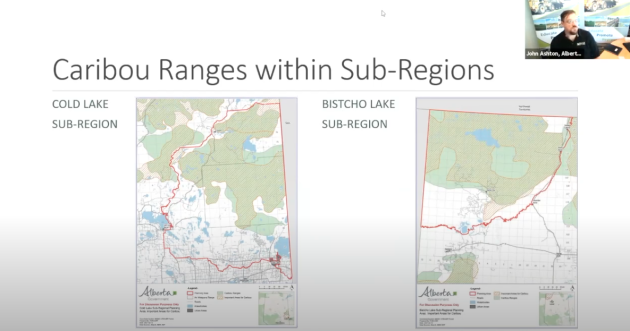
John Ashton, executive director of ASGA, shares maps of the caribou ranges with sub-regions.
The province implemented draft plans for caribou management in 2019 that may affect future development of pits and quarries, but did not include the aggregates industry as a stakeholder. First drafts of the plans for two test regions outlined limitations on the length of access to aggregate from long-term roads as 1,000 metres, up significantly from the previous limitation of 100 metres. This extends to all public lands, not just those in the designated caribou zone.
There’s also the possibility for a 250-metre buffer on wetlands and bodies of water, and sizing restrictions for operations and their maximum footprint.
The two test regions were not overly important to the aggregates industry, Ashton said, but act as a proving ground for future regions, and the industry must continue lobbying for inclusion in the province’s planning process.
“We have had other industries point out our absence as well, and say hey, why isn’t aggregates here, why isn’t gravel here?” noted Ashton.
Watch the government relations session here and the caribou management session here.
Artificial sand: A new revenue stream
One of the newer technologies changing the face of the aggregates industry is manufactured sand, also known as artificial sand. Quarry Tech moderator Andrew Snook tackled the topic in a panel discussion with John Bennington, product champion for washing and classifying at Superior Industries, Tyson Craiggs, aggregate resource manager at Terus Construction, and Alex Caruana, national manager for Canadian aggregates at Polydeck.
In an overview of the technical aspects of making artificial sand, which is crushed from a source such as limestone, Caruana succinctly explained the benefits: if your operation is not close to a market resource, “you simply have to find something else.”
Manufactured sand also can cut down on trucking costs since it can be produced onsite. “It really becomes a localized story based on where you are – where the ready-mix is being produced or where the local project is,” said Caruana. “Trucking can really start biting into that landing cost to the point where it meets or frequently exceeds the value of the material itself.”
The cubic shape of the granules results in a uniform consistency and compressive strength that is appealing to concrete producers. It’s “been refined a little bit more and is a little bit less susceptible to variations in your deposits and contaminants,” said Caruana. “You can have clay or other materials that need attrition – it’s quite a lot of effort to get them out. It takes very little of these materials to become detrimental to concrete. With manufactured sand, you eliminate a lot of that.”
During the session, Caruana shared how to assess strength, fines and sizing when making artificial sand, and what components are required for screening, dewatering, water usage and pond maintenance.
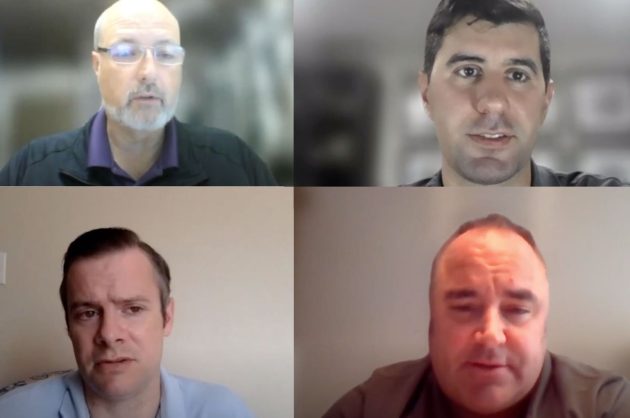
The “Future of Artificial Sands” panel at Quarry Tech 2021. Clockwise from top left: John Bennington of Superior Industries, Tyson Craiggs of Terus Construction and Alex Caruana of Polydeck.
He noted that manufactured sand is most commonly produced in quarries as an extra product over an exclusive one, and can help operators use every ton of material they have. In order to determine if it’s right for their operation, producers should have what he calls a “mountain of screening” – or an abundance of crushed resource. “If you can split up screenings into different things like manufactured sand and a saleable chip and a fertilizer product, then everybody wins.”
Bennington noted that equipment availability should also be a consideration. “One of the things that ends up happening is people take whatever piece of equipment that they have and they use it, whether or not it’s the right choice for that deposit and that process,” he said.
“One of the things that we see in the United States very commonly, especially in the northern Midwest — the Minnesota, Wisconsin, Michigan area — is people will dry feed their dust piles into sand screws. Especially if it’s limestone […] that really just doesn’t work. The material goes in dry into a large bath of water, and it ends up creating lumps of material that are wet on the outside and dry in the middle. It’s not uncommon for a feed material that goes in that’s like, 20 per cent, minus 200 mesh, and it comes out at 15, which is almost not worth having done. But that’s what they had handy and that’s what they used.”
“To that line of thought, it’s always best to design the system for your priorities, and then see if you have anything on hand,” said Caruana. “It’s really a matter of evaluating what your objectives and priorities are, and then seeing if there’s any economy to be obtained with existing parts or equipment.”
The demand for artificial sand continues to increase. For example, British Columbia now requires manufactured sand to be used in the top layer of all asphalt laid in the province. As a result, Terus Construction is expanding its usage. “We’re working with the ministry and municipalities to get our waste products in the specifications and bringing them to market so that the resources are maximized,” said Craiggs.
“Provinces aren’t just accepting it, they are embracing it because it’s a lower-resource input,” said Caruana.
Watch the future of artificial sands session here.
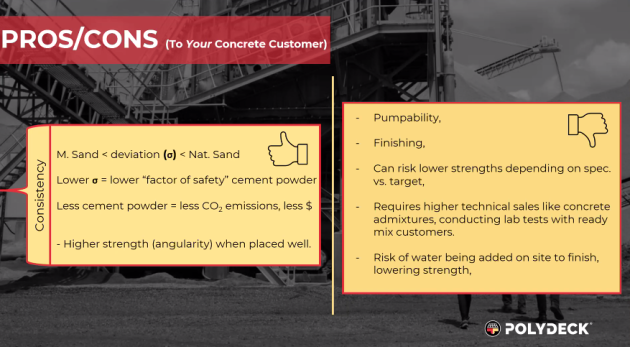
Caurana shared the pros and cons of artificial sand at Quarry Tech 2021.
Drones: Mapping pits and quarries
Maximizing resources was also the theme of a presentation on remote technologies. Advances in drone capabilities are allowing pit and quarry operators to unlock an incredible amount of data on their topography and their materials to be used in surveying, mapping and environmental research.
James Donaldson, sales manager for Canada at Wingtra, explained how drones that use vertical take-off-and landing are especially useful in challenging environments such as quarries.
“It takes off like a helicopter, then maps a mission like a plane, and then it lands like a helicopter as well,” he explained. “The benefits of having that is you get the crew speed when you’re mapping a mission with a fixed wing, so you can cover larger areas. And then you get the safety of switching back to a multi-rotor so that you can safely land and not destroy the body [of the drone].”
Wingtra’s drones, which can cover up to 600 acres in a single flight, provide in-flight monitoring and accurate measurements using high-megapixel cameras. Hundreds of data points then get transmitted into mapping software to be analyzed.
For example, the software can take drone imagery of stockpiles and calculate the volume and density, said Shaun McIntosh, senior account executive at Propeller Aero, a provider of 3D drone mapping software.
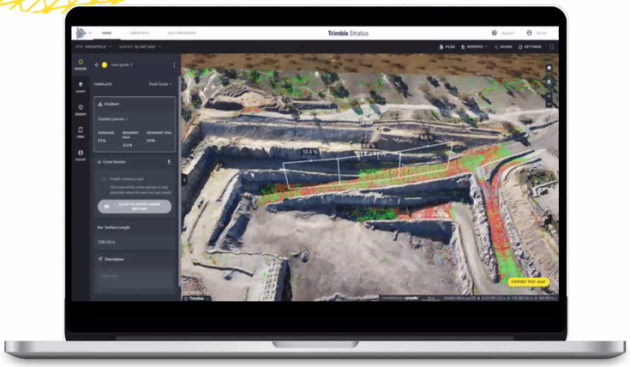
Propeller Aero’s drone mapping software at Quarry Tech 2021.
Drone mapping software also enables users to import design models for processes such as inspections and pre-and post-blast quantifications. On the roadbuilding side, they can also be used for establishing automated gradient maps.
“[We’re] able to do things like measure earth, or quantity. So if you’re doing stripping, you can look at benches and do pit planning,” McIntosh said. “[The tech] is getting a little bit more advanced.”
Repeated flyovers on a weekly or monthly basis can help operators keep track of the progress of cuts and fill areas. “It’s a really easy way to capture real-time data of what’s going on and plan the next phase of expansion,” said McIntosh.
Sensors affixed to heavy equipment can also be used in tandem with drones to provide a more complete picture of an operation or jobsite. For example, a sensor attached to a haul truck or grader “will track the X, Y and Z of that machine. We know the height, we know the width, we know the length,” said McIntosh. “Every time that machine comes down the slope, we’re actually mapping in real time the grade underneath the road itself.”
Watch the remote vehicles technologies session here.
Finding fossils: Operator training
Researchers from the Royal Alberta Museum were on hand at Quarry Tech to discuss the critical role that the aggregates industry plays in the recovery of 2.6-million-year-old Ice Age fossils.
Alberta is rich in fossils from the Ice Age – also known as the Quarternary period – but with the size of the province, the few researchers who specialize in these specimens “can’t be everywhere at once,” explained Christopher Jass, curator of Quarternary palaeontology at the Royal Alberta Museum (RAM). “A big part of what we’ve tried to do is generate interest from the industry side in the recovery of fossils, or at least in letting us know when they’re finding material.”
With 60 per cent of Ice Age fossils coming from gravel pits, the relationships the museum maintains with aggregate producers has become increasingly important, said Katherine Bramble, regulatory assistant in Quarternary palaeontology at the RAM.
Sand and gravel pits in Alberta have yielded bones belonging to now-extinct mammoths and mastodons, as well as horses, bison, moose, bears and other, seemingly non–North American creatures such as a sloth and an extinct species of camel.
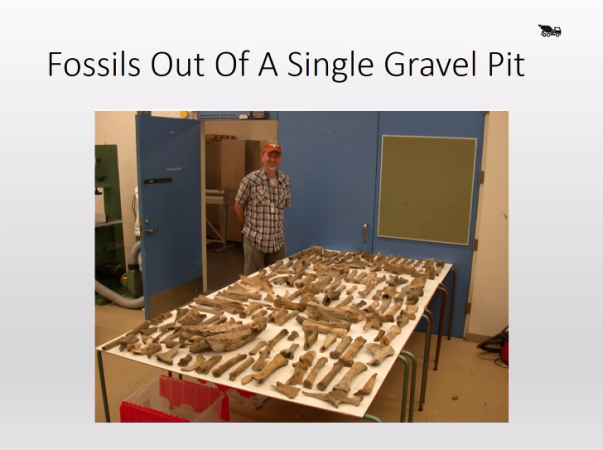
Curator Chris Jass with fossils at the Royal Alberta Museum that were discovered in a gravel pit.
“From the gravel pits, we’ve been able to get ancient DNA from some of the specimens, and because of that, we’ve been able to learn more about their history,” said Bramble. One of the more impressive fossils to have been recovered from a sand and gravel operation was the jaw bone of an American lion, said Jass. “It was uncovered by an excavator, ended up going down the conveyor belt and onto a shaker deck, and was pulled off before it went into a crusher. It still had the teeth intact.”
Aggregate producers in Alberta are subject to the Historical Resources Act, which protects all fossils discovered in the province as property of the crown. Companies can obtain booklets and posters from RAM to help educate staff on what to look for when it comes to identifying fossils in the field. Researchers from the museum are also available for site visits to train pit and quarry operators on what to look for.
“Our staff are a lot more cognizant because of these posters,” shared William Gowdy, manager, sustainability and environment for Northern Alberta at Lafarge Canada. The company has recovered over 1,000 specimens from its operations for RAM over the past several years.
When the Lafarge team finds bones or something that looks like a fossil, they’ll take a photo and send it to researchers at the museum, who then may visit the site for further exploration.
“One of the big concerns [people have] when it comes to reporting a fossil is, ‘If we report a fossil, will they shut our operation down?'” Bramble said. “That is highly unlikely to ever happen. When it comes to finding fossils, it’s usually it’s a bone here, a bone there. Because gravels are such high energy environments, it’d be extremely rare to find a full skeleton.”
In an extreme case where more than one bone is found, the museum can work with the producer to extract the fossils in one area as quarry work continues in another.
“Our main goal is to build relationships with industry. And we don’t want to sever any of those — if someone gets their pit shut down for reporting a fossil, they’re never reporting anything to us again,” Bramble said.
Gowdy indicated that work has never stopped on site because of a fossil discovery.
“We set it aside; we call them up. And we continue to work. It’s never adversely impacted our business to date.”
Watch the aggregates and palaeontology session here.
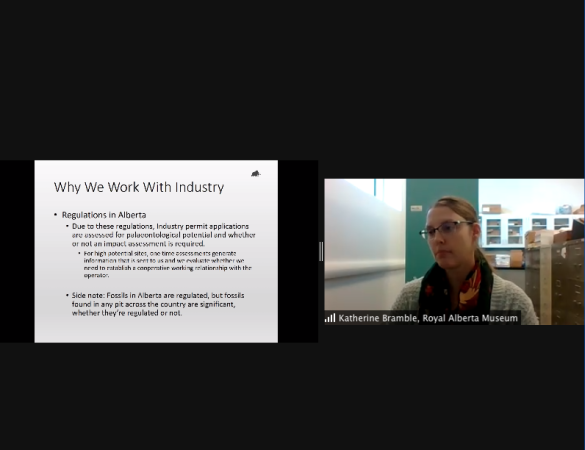
Katherine Bramble, assistant curator at the Royal Alberta Museum, discusses the relationships between science and industry at Quarry Tech 2021.
Watch online
Missed the live event? All sessions from Quarry Tech 2021 are now viewable on-demand! All of the sessions are free to watch – just register to unlock the content. And don’t miss the product demos in our Sponsor Showcase.
Thank you again to our sponsors for their support of Quarry Tech 2021, and for making this event possible: gold sponsors KLEEMANN, MB Crusher, and Polydeck, and silver sponsors BKT Tires, Frontline Machinery Ltd., Trimble Loadrite and Superior Industries Inc.
Have an idea for next year’s sessions? Contact Andrew Snook at asnook@annexbusinessmedia.com.
Print this page